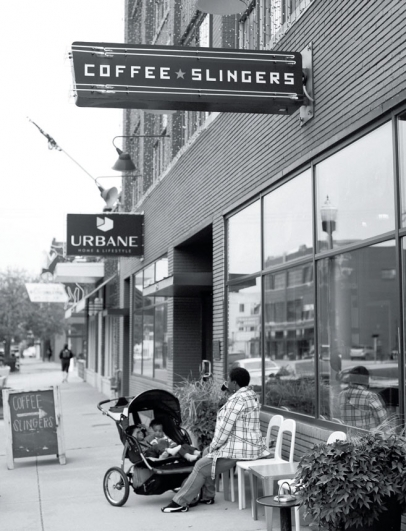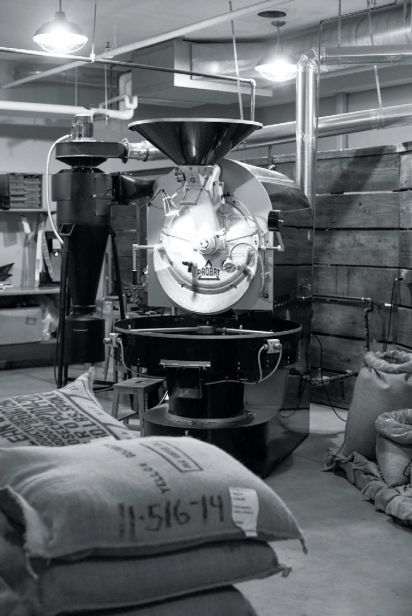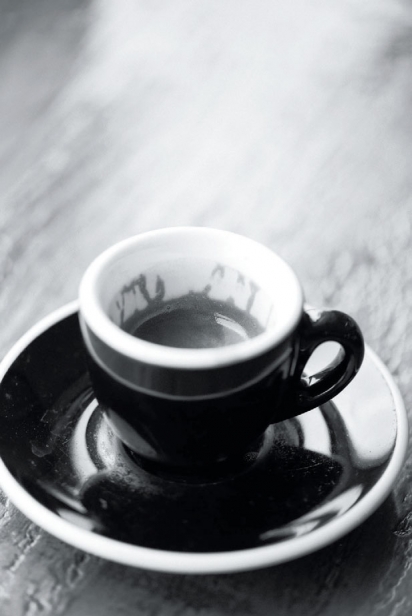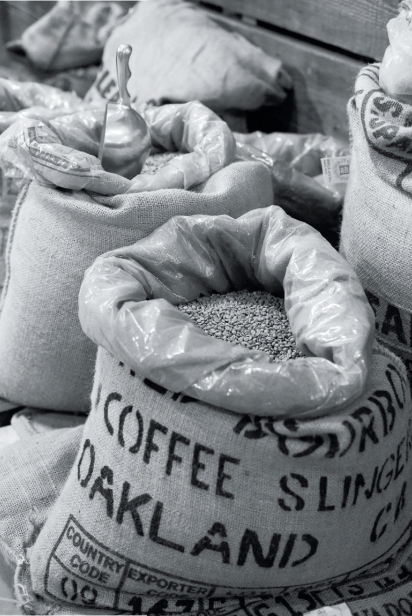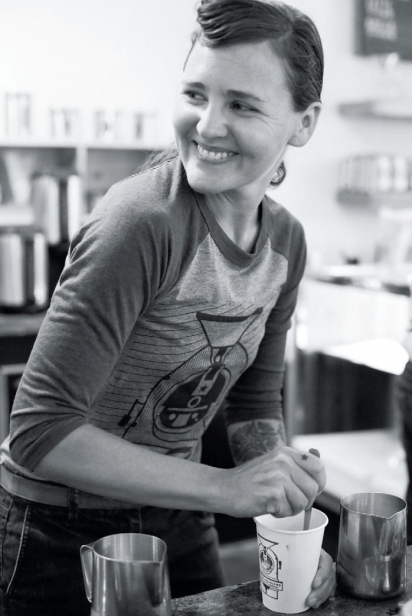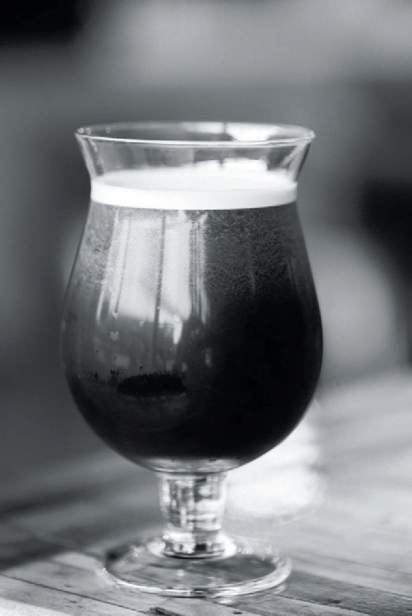Catch A Wave - Coffee Slingers Roasters
Coffee Slingers Roasters
When Melody Harwell first came to Oklahoma in late 2006, her mother kept telling her there was no great coffee here. Melody grew up in Washington state, and then lived in Hawaii, where she opened her own coffee shop. Melody, through long experience, knew great coffee. She looked around and decided she agreed with her mother.
The result was Coffee Slingers, a third wave coffee shop on Broadway in Automobile Alley. You are probably wondering what a third wave coffee shop is. To answer this question, we need to examine the history of coffee in America.
First, coffee. Coffee is made from roasted “beans” which are the seeds of the berries of Coffea plants. Coffea plants are flowering plants, and Coffea is the genus. Various species of the genus Coffea give us coffee. For example, the most common is the species Coffea arabica.
Coffea plants are believed to be native to sub-tropical Africa, and people also think coffee was first cultivated in Ethiopia. Coffee is now cultivated in many countries, although usually around the equator. Coffee plants are particular, requiring just the right combination of altitude and climate.
Different varieties are grown in different regions. Regions sometimes lend their names to coffee. For example, coffee is grown on the island of Java, in Indonesia.
Coffee is most commonly brewed, but there are a great many methods to make coffee. This brings us to the three waves of coffee.
It is generally accepted that coffee was first roasted and brewed in the Mocha region of Yemen. From the Middle East, coffee was exported to Venice, and spread throughout Italy from there. Coffee grew to become a valuable commodity, and was in demand in Europe and America.
However, it was not until the mid-1800s that industrialization and modern manufacturing techniques gave coffee the opportunity to appeal to the masses. That was the first wave of coffee. Companies like Folgers began to mass market coffee in the U.S.
From the mid-1800s to the 1970s, coffee consumption, while popular, was fairly uniform. Coffee was brewed, usually via the drip method, and consumed without much thought to origin or alternative styles.
In the early 1970s (and probably before) people in America began to be aware of other ways to make coffee. Although popular in Europe, methods like espresso or the French press were not widely known in America before this time.
The second wave of coffee brought an appreciation that different types of coffee (and different methods of roasting this coffee) were available, and that there were different, and better, ways to make coffee.
Companies like Starbucks and Peet’s popularized espresso drinks such as espresso, cappuccino, and the latte. The new methods and types of coffee were, and continue to be extremely popular. However, these institutions operate on a massive scale, and are unable to devote the time and attention to make coffee as good as it can be.
Third wave coffee is like craft beer, in that it is typically produced in small batches with extreme attention to all the things that differentiate bad coffee from good coffee from great coffee.
It is hard to pin down the origin of Third Wave coffee, but the term appears to have been first used in the early 2000s, but some shops employed the practices that define the third wave much earlier.
Third wave coffee shops are usually locally and independently owned. The owners of these shops saw a need to slow down and ask questions such as: what are we drinking? Why? Who grows it? Where does it come from?
Third wave coffee is made by applying culinary skill and equipment to roasting and making coffee. The equipment itself has led the revolution. Technology has enabled stabilization and consistency with different conditions. For you to understand the difference if you haven’t tried it, you need to hear my story.
I used to only drink coffee when I needed to stay awake, or for a quick lift. I really did not enjoy coffee, and I hated espresso. I also really did not enjoy the giant, sugar-filled “lattes” or “macchiatos” that some places make. This changed for me in 2004 when I was living in Tulsa. A shop opened there which I now realize was probably the first third wave shop in Oklahoma.
That shop is Doubleshot Coffee, owned by Brian Franklin. Brian sources and roasts coffee for his shop, and he uses great care in making coffee. He talked me into trying an espresso one day, and it was a revelation. Espresso is not supposed to be scalding hot and bitter. Brian’s espresso was none of those things. It was creamy and delicious. It tasted like coffee smells. I was hooked. Brian told me that most of the heavilyroasted, oily coffee beans available in the mass market were burned, and did not have the essential oils still in them.
This brings us back to Oklahoma City. My wife and I moved here from Tulsa in 2005, and I thought I was doomed to wander in the coffee desert. There were and still are coffee shops here, but I could not find a place that could make that truly great espresso to which I had become addicted.
All this changed when Coffee Slingers opened in early 2008 on Broadway and 10th in Automobile Alley. As far as I know, Coffee Slingers was the first third wave shop in Oklahoma City. There are now other Third Wave shops here and in surrounding towns, and the coffee culture in Oklahoma City is light-years ahead of where it was.
I sat down with Melody and asked her why her coffee, and that of other third wave shops, is so much better than the mass-market stuff. She told me that you have to start with the coffee itself. Most mass-market coffee is roasted for far too long. This is to try to make the taste uniform. Unfortunately, the taste is uniformly over-roasted and sometimes burned. Using a lighter touch brings out the unique flavors of each coffee. Coffee roasters engage in coffee “cupping” with the same rigor that wine enthusiasts use to taste and grade wine.
For our purposes, coffee starts as the green, unroasted beans (there is a fascinating story about how coffee gets to this stage, but it is a long story for another time.) Coffee roasters typically buy green coffee yearly from the producers. The “season” for picking is January to March, for Central American coffee. Roasters who have relationships with producers must estimate their coffee needs and buy the green coffee once early in each year, for delivery in August or September.
Most coffee used by third qave roasters and shops is overseen by small producers in coffee-growing regions. Typically, the producer owns the land, and seasonal pickers come in to pick the crop. The producer is on-site, looking at the growing coffee daily.
Melody has relationships with her producers, and she negotiates deals in person at the producers’ farms. She makes her choices about what to order after cupping the coffee with the producer to see what each crop will be like.
This is a critical step, as there is heavy competition for the “best” coffees: a mistake in ordering can have costly repercussions.
Good coffee is like fine wine, in that a particular producer will have crops that differ from year to year based on growing conditions. A coffee you really like one year may be very different the next year.
The shelf life of the green coffee is approximately eight months to a year. The green coffee must have enough humidity in it (it must be fresh enough) to roast endothermically. This means the water is converted to steam and roasts the bean from the inside out. If the green coffee is too old, and thus too dry, the bean will roast only exothermically, and will char on the outside, leading to a charcoal or burned taste. This is common in many mass-roasted coffees.
Once the green coffee makes its way back to Oklahoma, Melody roasts the green coffee weekly at her shop. Humidity and temperature have a huge effect on the roasted coffee, and she must control for both, along with many other factors. She roasts and cups several test batches, and selects the best profile for each batch.
The reason that I didn’t think I liked espresso was that I never had one that was made properly. What I love about espresso is the crema. Crema is a combination of carbon dioxide, air, and the fats and oils present in properly roasted, fresh coffee. A good espresso shot will have a nice crema when it is first pulled. Crema is ephemeral, and it will be gone before you know it, so you must drink your espresso promptly if you want to appreciate the crema. Crema also acts as an insulator, and helps keep the shot from tasting too hot.
Making espresso is the province of baristas. They make the espresso (known as pulling a shot) for the cappuccinos, macchiatos, and lattes that you enjoy. One does not simply decide to be a barista and start making great espresso.
Melody tells me that a barista might be competent after a month of intensive training, but that the “game” doesn’t really slow down for them until after about four months of solid work.
Baristas are always learning, and are always taking the weather into account. Again, temperature and humidity, along with myriad other factors, such as water quality, and roast date, greatly affect the quality of espresso. These factors can change throughout the course of a day, so a good barista is always making adjustments to create a quality shot each time. You may have seen a barista throw out a shot they did not think was good enough.
So how do you make a good espresso? First, you really need a massive commercial espresso machine. Home machines do not really have the capability to reach the extreme pressure needed. Pressurized, almost boiling water is forced through the ground and packed coffee, and it is through changing variables such as grind, packing, pressure, and time that great espresso is produced.
In addition to espresso, there are a great many ways to make coffee. The afore-mentioned French press and the pour-over are two methods for making hot coffee. Cold-brewing is a way to make coffee without heat.
Besides the hot coffee, Coffee Slingers has a very interesting new coffee drink they call “Nitrane.” Nitrane is a cold brew (coffee, not alcohol) that is served on nitrogen, like a Guinness or other stout beer. The nitrogen cascades through the cold brew, and lends a unique texture to the coffee. It is great year round, but really nice when the weather is hot.
If you have ever talked with Melody, or with Brian, or with any successful third wave shop owner, you realize these people are intensely focused on making great coffee, probably to the point of obsession. They live by the credo that was (probably incorrectly) attributed to the great architect Ludwig Mies van der Rohe: “God is in the details.” Fortunately, their obsession is our gain.
Whether you are familiar with third wave coffee or not, there are great local spots you should check out. Since Coffee Slingers opened, other third wave coffee shops have come into the OKC metro market. Some local third wave shops are: Coffee Slingers (coffeeslingers. com); Elemental Coffee at 8th and Hudson (elementalcoffee.com); Cafe Evoke in downtown Edmond (cafeevoke.com); or the Gray Owl in Norman (223 E. Gray, Norman). Please also be aware that great coffee is a complicated subject, and certainly any errors or inartful descriptions in this article are solely the author’s.


